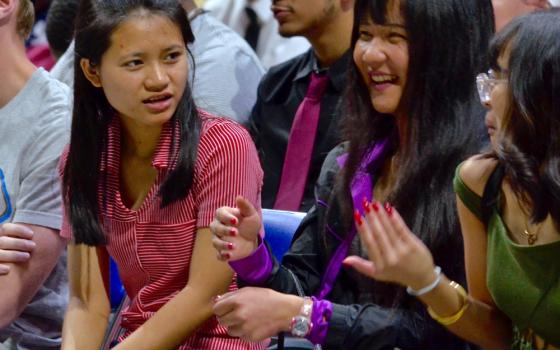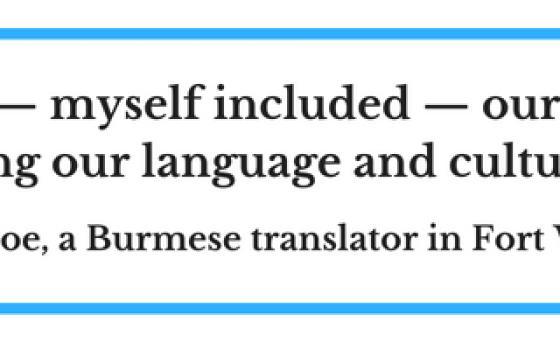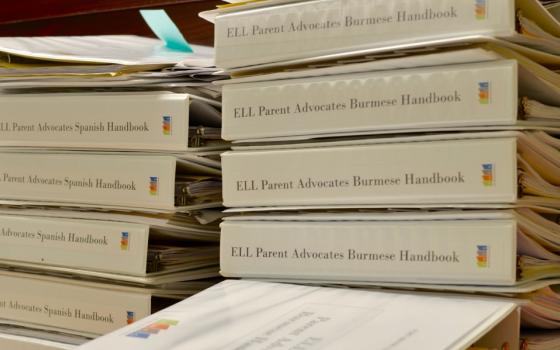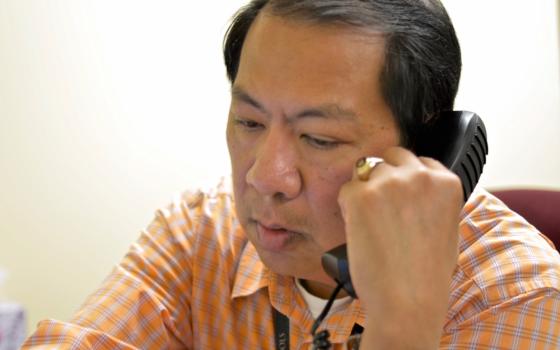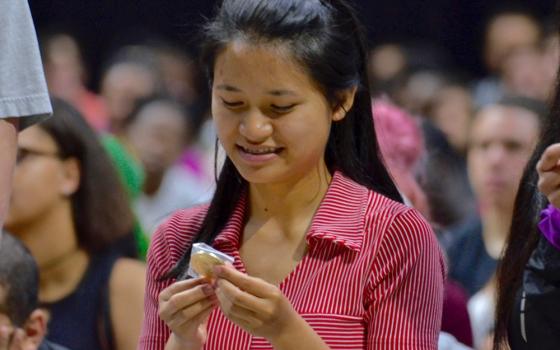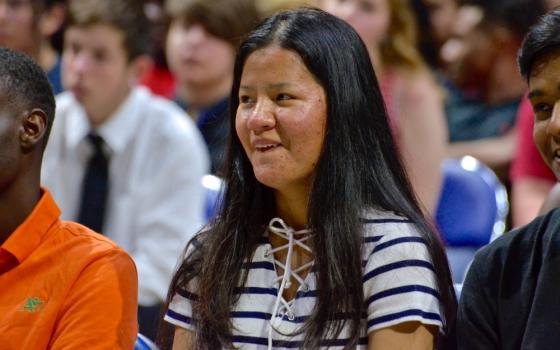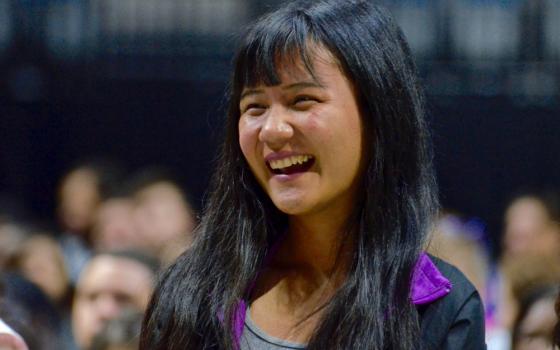Editor's note: Global Sisters Report is bringing a sharper focus to the plight of refugees through this special series, Seeking Refuge, which follows the journeys refugees make. For more GSR coverage on migration around the world, click here.
______
Niang En Chin was in second grade when her family fled their home in Myanmar.
Niang's family is from the ethnic Chin minority, which is persecuted in Myanmar. Most Chin are Christian, having converted under British colonial rule, and suffer at the hands of the military regime ruling the country, which prefers the Buddhist majority.
Niang, now 18, has thrived in Fort Wayne, Indiana, where her family was settled in 2010. She graduated as one of the top 10 students in her class at North Side High School in June and plans to attend Indiana University in the fall, her first step in her plan to become a doctor.
Niang never wants to forget her roots, she said, but what she remembers most about Myanmar is fear: fear of starving, fear of not being able to get an education, fear of the police.
Now, Niang and her Burmese high school friends have a different concern: Losing their language and culture as they try to integrate and succeed in a new society. Niang can speak her native Burmese language and can read a little bit of it, but she cannot write in it.
America has long been known as a melting pot, but those who work with refugees say that idea misses the point. In a melting pot, the ingredients lose their individuality and become one with the whole. Rather than assimilation, they say, the goal should be integration — to be part of the whole without losing cultural, ethnic and religious identity.
But refugees trying to integrate into a new society are often so focused on fitting into a world where everything is different that cultural identity becomes a secondary concern, said Margaret Distler, executive director of the St. Joseph Community Health Foundation in Fort Wayne, a sponsored ministry of the Poor Handmaids of Jesus Christ.
Distler's work allows her to see the often invisible but profound change that happens as a refugee integrates into a new society.
"There's a point — usually when they've been in the country about three years — where they go from living day-to-day to doing some planning," she said. "Once you learn how to live, you start looking forward. You go from, 'How do I survive?' to 'How do I thrive?' "
As of 2016, about 6,000 Burmese refugees have been settled here since 1991, after Myanmar's military crushed a pro-democracy uprising in 1988 and tens of thousands of Burmese fled to refugee camps in Thailand and Malaysia. Others are Muslim Rohingya and Christian Chin fleeing religious persecution.
Rohingya began arriving in Fort Wayne in 2013 and now number more than 1,000 — the largest Rohingya community in the United States, reports the Indianapolis Star. The Burmese mosque built here in 2015 was the first Burmese mosque constructed in the world in more than three decades.
Today, the total number of Burmese in Fort Wayne is closer to 20,000 because of children born to Burmese refugees and secondary migration, in which Burmese who had been settled elsewhere moved to be near relatives or the large Burmese community in Fort Wayne, said Kyaw T. Soe, a Burmese translator in the area. Fort Wayne's total population is approximately 266,000.
The Poor Handmaids are an integral part of the story of Burmese refugees in Fort Wayne. Working with Catholic Charities, the official resettlement agency in Fort Wayne, their St. Joseph Community Health Foundation created and funded the Burmese Advocacy Center, which from 2008 to 2013 coordinated assistance to the thousands of Burmese refugees resettled here before officials decided it wasn't needed anymore.
The Burmese Advocacy Center was a one-stop gateway to 10 different agencies helping refugees, such as state assistance, volunteer interpreters and job training.
"We were the local convener of services," Distler said.
The number of Burmese refugees arriving peaked in 2007 and 2008, when more than 1,400 Burmese refugees arrived; since then, the numbers have been as low as 40 in 2012 and nearly 300 in 2015, The Journal Gazette reported. They have fallen off in recent years as democratic reforms in Myanmar have caused fewer Burmese to seek asylum; in 2014, the United Nations' refugee agency stopped accepting new applications for resettlement to the United States from Burmese in nine refugee camps in Thailand.
The large numbers arriving in 2007 and 2008 strained the city and county's social services, Distler said, and the Burmese Advocacy Center not only allowed refugees to find the services they needed in one place, but also allowed agencies to coordinate and target those services while avoiding duplication. Though Catholic Charities provides refugees with an apartment and a list of basics, there is much they still need and need help to find.
"Their needs were extensive," she said. "They had very little income when they came here."
Yet another challenge
Every challenge refugees face trying to integrate seems to involve trade-offs, even language, Niang said. Children not yet in school may be fluent in Burmese or one of Myanmar's many ethnic languages, but not English; teens like her are afraid of losing their native language but have to concentrate on being fluent in English; and adults may struggle to learn just enough English to get a job, she said.
Some ethnic Burmese who were born and raised in Fort Wayne speaking, reading and writing English are on the other side: struggling to learn the Burmese language, which they have never spoken or read.
Soe, a translator for Fort Wayne Community Schools, teaches Burmese language to Burmese who have lost it or never had it.
"If they cannot read and write in Burmese, they can't get back to Burma, they can't communicate with family members, and they can't help their parents here," Soe said.
Language is also a key part of culture, and while the refugees gave up almost everything when they fled Myanmar, many are determined not to give up their cultural identity.
"Every parent — myself included — our biggest fear is our children losing our language and culture," Soe said. "It is priceless."
Some struggle to integrate for the rest of their lives. The longer a migrant spent in a refugee camp before resettlement, the longer it takes for integration, Distler said. Age is a factor, too: People over 40 don't integrate into society as quickly as younger refugees.
"Parents would focus on their kids and not have time for themselves to learn the language," she said. "Often, they would be stuck in endless poverty."
The hope for a completely different life has sustained refugees for generations, said Sr. Joellen Tumas, a sister of the Poor Handmaids of Jesus Christ, which came to the United States in 1868 from Germany. The congregation, based in Donaldson, Indiana, about an hour west of Fort Wayne, this year is celebrating 150 years in the United States.
"We came as an immigrant community — immigrants to serve immigrants," Tumas said. "Over the years, as the faces of immigrants have changed, we've served different groups of people, but they're all refugees and immigrants."
"Whatever the need is, we are there," Tumas said. "And we're always looking for a new need. A lot of times, we don't have to look for it. It falls in our lap."
Bridging the health care gap
By 2012, Distler said, officials at the St. Joseph Community Health Foundation realized that about 60 percent of the people the Burmese Advocacy Center was serving had figured out how to navigate the American system and were thriving. Staff then looked around and found there were 23 agencies in the community that were already effectively providing services to refugees, so St. Joseph Community Health Foundation resources could probably be better used elsewhere. They closed the Burmese Advocacy Center and turned to a new effort: medical interpreters.
The foundation's core mission is to ensure health care is accessible to the most vulnerable, including refugees trying to integrate into the community, Distler said. It is difficult or impossible to integrate if health conditions make you unable to work or get around, she said, and medical interpreters can bridge the gap between refugees and the health care they need.
Though the foundation and other agencies helped train many translators over the years, they were proving inadequate when it came to the interaction between doctor and patient.
"We had a lot of bilingual people, but someone who is bilingual is not necessarily trained as an interpreter," Distler said. "And interpreting medical or legal issues is another thing entirely."
Medical interpreters must be trained in U.S. confidentiality laws and about when not to paraphrase, she said, but also must learn things such as where to stand: They should stand behind the patient, so the native language is like a voice in their head, and the doctor can look the patient in the eye.
Distler said becoming a medical interpreter requires about 65 hours of intense training, but the programs the foundation funds have qualified more than 40 Burmese for medical interpretation, as well as 69 others speaking 18 languages.
Some of those have gone to work for the Fort Wayne-Allen County Department of Health, where they have been crucial, said Dr. Deborah McMahan, the county health commissioner.
"The sisters and the St. Joseph Community Health Foundation, they're such a great example of putting your money where your mouth is," McMahan said. "I'm so grateful for those trained medical interpreters. They've really changed the way we're able to care for people."
McMahan said refugees get minimal health screening before they are resettled, and those screenings focus on acute and short-term health problems such as water-borne infections, but not issues such as diabetes or HIV.
It would be easy to focus on the problems refugees bring, McMahan said, but seeing treatment and prevention as an investment rather than just another expenditure puts the focus on what refugees can contribute.
It is much easier to address those issues for those who know how to navigate the system and are not focused solely on survival, McMahan said.
"When you're in a refugee camp, every day, you get your food given to you, you can't work, your life is on hold," she said. "Then you bring them here, and you change all that. They drive an hour and a half, work all day, drive an hour and a half back, go to the store to get food. They have to learn how to work with money, and they have ... to figure out how to live a new life here. It's crazy."
And refugees bring more issues with them than physical health.
"I don't think the average American understands how traumatized these people can be," she said. "Americans don't have to worry about people breaking into your home, raping your wife and children in front of you, and then killing them."
Dealing with those issues in the refugees they knew about was hard enough, McMahan said, but there was no way to know about those who came to Fort Wayne in secondary migration until the department began doing medical exams for people applying for green cards.
"We see a lot of tuberculosis outbreaks in the secondary migration refugees because they get a health exam when they arrive in Chicago or Indianapolis, but then they move here before they're treated," she said.
McMahan said investing more in addressing basic issues such as health, housing, financial skills and education would allow many more refugees to fulfill their potential rather than working 70 hours a week in a factory, as many do.
"It's great to have Asian restaurants and groceries, but I'd like to have Burmese doctors and Burmese architects," McMahan said.
'A big hope'
Niang is determined to see McMahan's dream of a Burmese doctor come true. Niang is one of five students in the top 10 students of her North Side High School graduating class who were not born in the United States. Three, including Niang, were born in Myanmar; one was born in Thailand and raised in Myanmar; and one is from the Philippines.
If you ask Niang about the difference between her life in Myanmar and her life in Fort Wayne, the answer is, "everything."
"Here, we don't have to worry about food," she said. "We don't have to be scared. We don't have to be afraid of the police."
How did she go from a refugee not allowed to attend school in Malaysia to preparing to study pre-med?
"We had a big hope, I guess," she says.
She also wants to share that "big hope" with others. Once she's a doctor, she said, she wants to set up clinics in the United States to provide free or low-cost health care and eventually do the same in Myanmar.
"I hope for a good education, I hope to be a doctor, I hope to be successful," Niang said. "That's what keeps me going."
[Dan Stockman is national correspondent for Global Sisters Report. His email address is dstockman@ncronline.org. Follow him on Twitter or on Facebook.]
Next in this series: Sisters and Catholic organizations in Kansas fill the gaps after the state withdraws assistance to refugees from any country.
